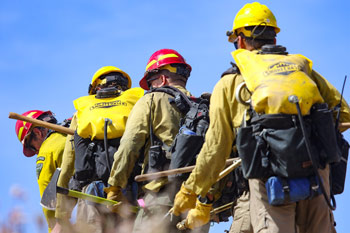Click Here for California Fires
July 21, 2024 - More than 21,100 wildland firefighters are assigned to wildfires nationwide, including 21 complex and 6 Type 1 incident management teams, 520 crews, 1,230 engines,  multiple aviation resources and four modular Modular Airborne Fire Fighting Systems, or MAFFS.
multiple aviation resources and four modular Modular Airborne Fire Fighting Systems, or MAFFS.
As of this morning, 63 large active wildfires are being managed and have burned 1,083,684 acres. Fire managers are using full suppression strategies on 57 of these wildfires. Many wildfires in the Northwest area continue to have active to extreme fire behavior. The Durkee Fire burned nearly 60,000 acres yesterday, and the Lone Rock Fire gained more than 16,000 acres
Evacuation orders are in effect for residents near the Lone Rock, Battle Mountain Complex, Falls, Durkee, Cow Valley, Cougar Creek, Pioneer, Diamond Complex, Boneyard, Swawilla, Larch Creek, Monkey Creek, Hill, Ridge, and Bench Lake fires. If you live in an area that has been evacuated, please follow the instructions from local authorities. They will provide the latest recommendations based on the threat to your community and appropriate safety measures.
The Great Basin Coordination Center's predictive services staff have issued three fuels and fire behavior advisories for Nevada, Southern Idaho and Utah and Arizona Strip. There is also a fuels and fire behavior advisory in effect for California. Residents, travelers, or workers on their way to any of these states should be advised and familiarize themselves with the elevated risks.
The national predictive services staff at the National Interagency Coordination Center released the National Significant Wildland Fire Potential Outlook for July through October. For additional information about the current outlook visit the Outlook page on the NICC site.
Preparedness level 5 means that national resources are heavily committed, and additional measures are being taken to support geographic areas as possible. Full commitment of national resources is ongoing, and the potential for emerging significant wildland fires is high and expected to remain high in multiple geographic areas. Learn more about preparedness levels.
Isolated dry thunderstorms may be ongoing from the Cascade crest westward in Oregon as the upper-level wave moves northward, with isolated dry thunderstorms likely to continue during the day as they move into central and western Washington. Scattered mixed wet and dry thunderstorms are likely to develop across south-central into eastern Oregon during the afternoon as well and possibly into far northeast California, southwest Idaho, and northwest Nevada. Hot, record-setting temperatures with low afternoon relative humidity below 20% and poor overnight recovery are expected across the Inland Northwest, northern and western Great Basin, northern Rockies, and into California. Breezy westerly winds are likely in the Cascade Gaps of Oregon into northeast California as well. Deeper monsoon moisture will bring scattered wet thunderstorms to much of the Southwest and central Rockies, with more isolated wet thunderstorms into central Nevada and Wyoming. Scattered to widespread showers and thunderstorms will develop along a stalled front from the central Texas to the Southeast coast, with scattered showers and thunderstorms extending into the western Mississippi Valley. Cool and dry conditions will continue across much of the Great Lakes and Northeast with light winds, although a weak cold front could bring isolated showers and thunderstorms to the Great Lakes.
| Number of new large fires or emergency response * New fires are identified with an asterisk |
10 | States currently reporting large fires: |
| Number of active large fires Total does not include individual fires within complexes. |
63 | |
| Acres from active fires | 746,284 | |
| Fires contained | 5 |
Year-to-date statistics
| 2024 (1/1/24-7/21/24) | Fires: 26,048 | Acres: 3,408,998 |
| 2023 (1/1/23-7/21/23) | Fires: 28,249 | Acres: 827,515 |
| 2022 (1/1/22-7/21/22) | Fires: 35,487 | Acres: 5,538,851 |
| 2021 (1/1/21-7/21/21) | Fires: 35,588 | Acres: 2,636,109 |
| 2020 (1/1/20-7/21/20) | Fires: 29,437 | Acres: 1,846,082 |
| 2019 (1/1/19-7/21/19) | Fires: 23,828 | Acres: 2,464,290 |
| 2018 (1/1/18-7/21/18) | Fires: 35,419 | Acres: 3,654,870 |
| 2017 (1/1/17-7/21/17) | Fires: 35,823 | Acres: 4,774,472 |
| 2016 (1/1/16-7/21/16) | Fires: 30,964 | Acres: 2,866,680 |
| 2015 (1/1/15-7/21/15) | Fires: 33,340 | Acres: 5,509,546 |
| 2014 (1/1/14-7/21/14) | Fires: 30,636 | Acres: 1,306,163 |
| 2014-2023 | Fires: 31,858 | Acres: 2,769,978 |
Source: NIFC








